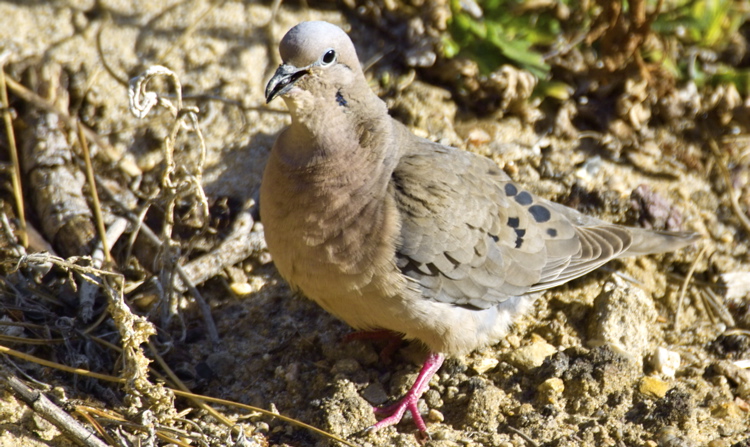- Eared Dove
image_width = 240px
status = LC
status_system = iucn3.1
regnum =Animal ia
phylum =Chordata
classis =Aves
ordo =Columbiformes
familia =Columbidae
genus = "Zenaida"
species = "Z. auriculata"
binomial = "Zenaida auriculata"
binomial_authority = (Des Murs, 1847)The Eared Dove, "Zenaida auriculata", is a
New World tropicaldove . It is a resident breeder throughoutSouth America fromColombia to southernArgentina andChile , and on the offshore islands from theGrenadines southwards. It may be a relatively recent colonist ofTobago andTrinidad . It appears to be partially migratory, but details are little known, although migration may be driven by food supplies.It is a close relative of the North American
Mourning Dove . With thatspecies , theSocorro Dove , and possibly theGalápagos Dove it forms asuperspecies . The latter two are insular offshoots, the Socorro birds from ancestral Mournming Doves, the Galápagos ones from more ancient stock. [Johnson & Clayton (2000)]Description
The Eared Dove is 24 cm long with a long wedge-shaped tail, and weighs normally about 112 g. Adult males have mainly olive-brown upperpart plumage, with black spots on the wings. The head has a grey crown, black line behind the eye, and the blue-black on the lower ear coverts. These black markings give the species its English and specific name. The underparts are vinous, and the tail is tipped with cinnamon. The bill is black and the legs dark red.
The female is duller than the male, and immatures are greyish-brown, very dull, with pale barring. The
species ' call is a deep soft "oo-ah-oo".Ecology
The Eared Dove is common to abundant in savannahs and other open areas, including cultivation, and it readily adapts to human habitation, being seen on wires and telephone posts near towns in Trinidad and
Venezuela , almost in all public spaces of large urban areas such asBogotá , Colombia and feeding near beach resorts in Tobago.Eared Doves feed mainly on seed taken from the ground, but will take other items such as soaked bread. They can be agricultural pests. This is a gregarious bird when not feeding, and forms flocks especially at migration time or at communal roosts. Its flight is high, fast and direct, with the regular beats and an occasional sharp flick of the wings which are characteristic of pigeons in general. It also has a breeding display with a steep climb and semi-circular glide down to its original perch. It builds a small stick
nest several meters up in a tree [Cisneros-Heredia (2006)] and lays two white eggs. These hatch in 12–14 days with another 9 days to fledging. There appears to be no fixed breeding season in most of their range, and provided with plentiful food and habitat birds will breed almost continuously.Hunting
Eared Doves provide the last big-bag shooting experience in the world. There are reckoned to be more than 23 million of these doves in the fields around Córdoba in northern Argentina and it is not unknown for a single gun to shoot 1000 birds in a day.
The scale of this wing-shooting recalls the numbers of
Passenger Pigeon s taken by North American gunners in the 1800s. That hunting pressure brought the Passenger Pigeon to rapid extinction, but the Eared dove seems to be more resilient. Indeed, as with the Passenger Pigeons, Eared Dove populations in Argentina and Bolivia sometimes "darken the skies". Thus, it seems that populations on the sporting estates of Argentina are holding their own, with the birds breeding four times a year and thriving on the vast areas of grain, some grown for their benefit, most of it on commercial farms which are happy to support the dove shooting.The
Estancia de los Chanares , one of the luxury lodges which specialise in dove hunting, estimates that there are one million doves on its estate alone. The season extends right round the year.The Eared Doves around Córdoba do not migrate, and the enormous flocks are described as flying constantly between their roosting woods and the open fields.
Further north, in
Bolivia , around de Gran Chaco region, near the inmense soy and sorghum plantations around Santa Cruz de la Sierra, the dove shooting is more seasonal, going from May to September with large flocks arriving from Argentina to raid the grain crops. Locals atest that Eared Doves, which they call by theGuaraní name of "totaky" were quite rare in the region just a couple of decades ago, a testimony not only to the resilience of the species but to the huge impact that the newly-created large feeding grounds have on dove populations.Footnotes
References
*|year=2004|id=48781|title=Zenaida auriculata|downloaded=09 May 2006 Database entry includes justification for why this species is of least concern
* (2006): Notes on breeding, behaviour and distribution of some birds in Ecuador. "Bull. B.O.C." 126(2): 153-164.
* (2003): "Aves de Patagonia, Tierra del Fuego y Península Antártcica". [in Spanish] . [http://www.fantasticosur.com Editorial Fantástico Sur Birding Ltda] . ISBN 956-8007-03-2
* (1991): "A guide to the birds of Trinidad and Tobago" (2nd edition). Comstock Publishing, Ithaca, N.Y.. ISBN 0-8014-9792-2
* (2003): "Birds of Venezuela". Christopher Helm, London. ISBN 0-7136-6418-5
* (2000): A Molecular Phylogeny of the Dove Genus "Zenaida": Mitochondrial and Nuclear DNA sequences. "Condor" 102(4): 864-870. [http://elibrary.unm.edu/sora/Condor/files/issues/v102n04/p0864-p0870.pdf PDF fulltext]External links
* [http://ibc.hbw.com/ibc/phtml/especie.phtml?idEspecie=1831 Eared Dove videos] on the Internet Bird Collection
* [http://www.5starsporting.com/argentina_dove_hunting.aspx Eared Dove Hunting in Argentina] at 5 Star Sporting Gaucho Lodge in Córdoba, Argentina
Wikimedia Foundation. 2010.

